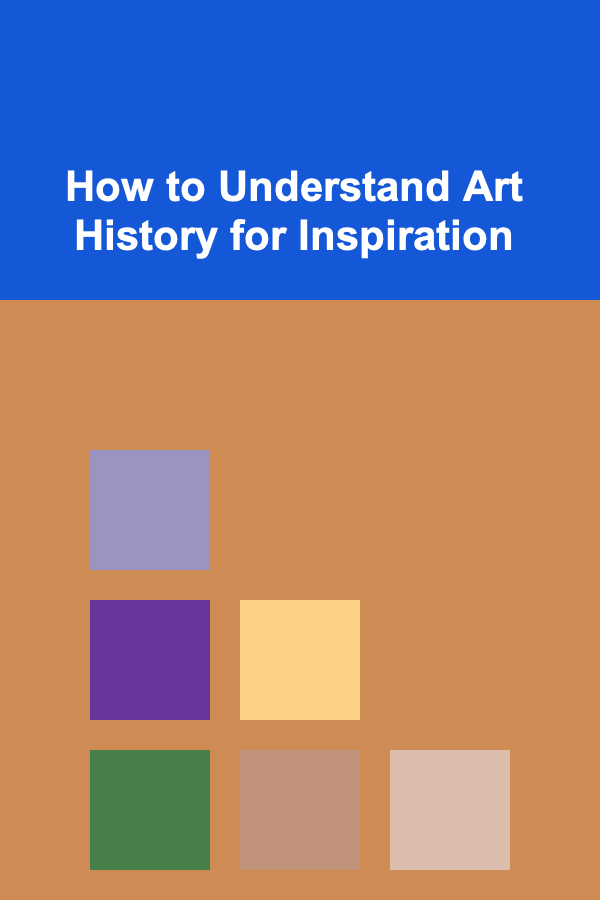
How to Understand Art History for Inspiration
ebook include PDF & Audio bundle (Micro Guide)
$12.99$5.99
Limited Time Offer! Order within the next:

Art has always been a reflection of society, culture, and personal expression. Throughout history, art has evolved in response to various influences, from politics and religion to technology and social movements. Understanding art history can be a powerful source of inspiration for creators, artists, writers, designers, and anyone seeking new ways to express themselves. By studying the movements, techniques, and concepts behind different art forms, individuals can draw from a vast well of creativity to fuel their own work.
This article will explore how to approach art history for inspiration, covering key periods, movements, and figures in the history of art, as well as practical ways to engage with and apply these influences in your creative process.
The Importance of Art History
Art history is the study of the development of art, from prehistoric cave paintings to contemporary digital art. It encompasses a wide range of disciplines, including painting, sculpture, architecture, and more recently, photography and multimedia art. Art history helps us understand how different societies and cultures have used visual expression to communicate ideas, values, and beliefs.
By understanding the evolution of art, we can appreciate the contexts in which these works were created. Art history is not just about admiring beautiful works but about understanding the motivations and influences behind them. This deeper understanding can serve as a springboard for new ideas and creative exploration.
Here are several reasons why understanding art history is crucial for finding inspiration:
- Cultural Awareness: Art history allows us to see how different cultures have approached creativity and self-expression, revealing diverse perspectives and experiences.
- Creative Innovation: Learning from the successes and failures of past artists can provide insights into new ways of approaching your own work.
- Understanding Techniques and Styles: By studying the techniques and styles of various artists, you can discover methods that resonate with your own practice.
- Connecting with Ideas: Art history allows you to connect with the ideas and philosophies that shaped artworks, offering profound insights that can influence your thinking and creative process.
The Key Periods and Movements in Art History
To understand art history in a meaningful way, it is helpful to familiarize yourself with the major periods and movements that have shaped the development of visual art. These periods and movements are not isolated but are interconnected, with one often influencing the next.
Prehistoric Art
Prehistoric art refers to the earliest known forms of art created by humans, primarily during the Stone Age. This period includes cave paintings, carvings, and sculptures made by early humans. The purpose of these artworks is still debated, but many scholars believe they were created for spiritual or ritualistic purposes.
Inspiration: Prehistoric art is raw and primal. The simplicity of these forms, such as the famous cave paintings at Lascaux, can inspire modern artists to reconnect with basic forms of expression. The sense of mystery and storytelling inherent in these ancient images can inspire creative reinterpretations in contemporary art.
Classical Art (Ancient Greece and Rome)
Classical art, particularly the art of Ancient Greece and Rome, emphasized ideals of beauty, proportion, and the human form. Artists of this period focused on realistic depictions of the human body and the natural world, exploring themes such as mythology, heroism, and virtue.
Inspiration: Classical art serves as the foundation for much of Western artistic tradition. The emphasis on proportion, balance, and symmetry can inspire modern artists to explore concepts of harmony in their own work. Greek and Roman mythology also provide rich material for visual storytelling, which can be applied to contemporary themes.
Medieval Art
Medieval art, spanning roughly from the 5th to the 15th century, was primarily influenced by Christianity and feudalism. Artists in this period often depicted religious themes, using symbolism and iconography to convey spiritual truths. Gothic architecture and illuminated manuscripts are some of the key artistic achievements of this time.
Inspiration: The symbolic nature of medieval art can inspire contemporary artists to explore the spiritual or symbolic meanings behind their own work. The intricate patterns and detailed craftsmanship of medieval art can influence the creation of works that combine beauty with purpose.
Renaissance Art
The Renaissance (14th to 17th century) marked a rebirth of interest in the classical ideals of Ancient Greece and Rome, alongside the development of new techniques and concepts. Artists like Leonardo da Vinci, Michelangelo, and Raphael revolutionized the understanding of perspective, human anatomy, and the use of light and shadow.
Inspiration: The Renaissance's focus on realism, perspective, and the human form can inspire artists to develop their technical skills and explore the portrayal of the human experience. The period also emphasizes the idea of the artist as a genius, a concept that encourages individual creativity and exploration.
Baroque Art
Baroque art, which flourished in the 17th century, is characterized by its dramatic use of light, intense emotion, and grandeur. Baroque artists sought to evoke strong emotional responses from viewers through dynamic compositions and exaggerated forms. Figures like Caravaggio, Rembrandt, and Bernini exemplify the Baroque style.
Inspiration: The Baroque emphasis on drama, light, and movement can inspire artists to experiment with contrast and theatrical elements in their work. The emotional intensity of Baroque art can also encourage artists to delve deeply into the emotional and psychological aspects of their subjects.
Romanticism
Romanticism, which emerged in the late 18th century, was a reaction against the rationalism of the Enlightenment and the industrialization of society. Romantic artists focused on individualism, nature, emotion, and the sublime. Figures like J.M.W. Turner, Caspar David Friedrich, and Francisco Goya captured the power and beauty of nature and the emotional depth of the human experience.
Inspiration: Romanticism encourages artists to explore themes of nature, emotion, and individual expression. The movement's focus on the sublime and the mystical can inspire contemporary artists to create works that evoke awe and wonder.
Impressionism
Impressionism, which began in France in the late 19th century, marked a dramatic departure from traditional artistic techniques. Artists like Claude Monet, Pierre-Auguste Renoir, and Edgar Degas sought to capture fleeting moments and the effects of light and color, using short, quick brushstrokes and focusing on everyday scenes.
Inspiration: Impressionism encourages artists to explore color, light, and texture in innovative ways. The movement's emphasis on capturing the essence of a moment rather than fine detail can inspire contemporary artists to approach their subjects with a sense of immediacy and spontaneity.
Modernism
Modernism, which spanned the late 19th and early 20th centuries, was a broad cultural movement that sought to break away from traditional forms and embrace new artistic expressions. Artists like Pablo Picasso, Wassily Kandinsky, and Henri Matisse experimented with abstraction, geometric forms, and unconventional materials to explore the complexities of modern life.
Inspiration: Modernism encourages artists to push boundaries, break conventions, and experiment with new forms of expression. The focus on abstraction and the exploration of inner experiences can inspire contemporary artists to think outside the box and redefine what art can be.
Contemporary Art
Contemporary art encompasses a wide range of styles and mediums, from conceptual art and performance to digital art and installation. The late 20th and 21st centuries have seen an explosion of diverse artistic practices that engage with issues such as identity, politics, globalization, and technology.
Inspiration: Contemporary art reflects the complexities of modern life and offers endless possibilities for exploration. The use of new media and technologies can inspire artists to incorporate digital tools, multimedia, and interactive elements into their work.
How to Engage with Art History for Inspiration
Now that we've explored key periods and movements in art history, it's important to consider how to actively engage with art history to find inspiration. Here are some practical ways to approach art history as a source of creative fuel:
1. Visit Art Museums and Galleries
One of the best ways to engage with art history is by visiting museums and galleries. These spaces house some of the greatest works of art from different periods and cultures. Spend time studying the details of each piece, considering the artist's intentions, techniques, and the historical context in which it was created.
Tip: Take a sketchbook and notebook with you. Sketching and jotting down thoughts can help solidify your connection to the artwork and spark new ideas.
2. Read Art History Books and Articles
There are countless books, articles, and online resources dedicated to art history. Reading these can deepen your understanding of the movements and artists that have shaped art over the centuries. It can also expose you to lesser-known periods and artists who may provide a fresh perspective.
Tip: Look for books that focus on specific movements or artists that resonate with your work. These focused studies often provide in-depth insights and new angles that can inspire your creative process.
3. Analyze Art through Documentaries and Films
Documentaries and films about artists, art movements, or specific works of art offer a more visual and narrative-driven way to engage with art history. Many documentaries provide behind-the-scenes looks at the creative process and historical context, making the art feel more accessible and relatable.
Tip: Watch films or documentaries that focus on the artistic process and the stories behind the artists. This will help you understand the emotional and intellectual motivations that drove their work.
4. Study Art Techniques
Understanding the techniques used by artists throughout history can be a great source of inspiration. You can study everything from Renaissance perspective to Impressionist brushwork, learning how different artists achieved their effects.
Tip: Experiment with some of the techniques you've learned. By mimicking different styles, you may uncover new approaches that influence your own creative practice.
5. Explore Art in a Global Context
Art history is not limited to Western traditions. Many cultures, such as African, Asian, and Indigenous cultures, have rich artistic histories that offer unique perspectives and methods. Exploring global art traditions can expand your creative horizons and inspire new directions for your work.
Tip: Look into art from non-Western cultures or more obscure movements to gain a broader perspective on the diversity of artistic expression.
Conclusion
Understanding art history is a powerful way to find inspiration and deepen your creative practice. By studying the movements, techniques, and philosophies behind art, you can gain a greater appreciation for the diversity and complexity of human expression. Art history not only offers insight into the past but also provides a wellspring of ideas that can shape the future of creativity.
Whether you're an artist, writer, designer, or simply someone seeking new ways to express yourself, engaging with art history can spark fresh ideas and fuel your passion for creation. The world of art is vast and ever-evolving, and there's always more to discover and learn. The key is to stay curious, keep exploring, and allow art history to inspire your own journey of creative expression.

How to Evaluate Party Planning Companies for Your Next Event
Read More
How to Find Reliable Contractors for Your Home Rental Property
Read More
How to Use Rewards to Stay Motivated with Time Management
Read More
How to Master Lymphatic Drainage for Face and Neck
Read More
How to Create a Messy Bun That Looks Chic
Read More
How To Combat Acne Breakouts Effectively
Read MoreOther Products

How to Evaluate Party Planning Companies for Your Next Event
Read More
How to Find Reliable Contractors for Your Home Rental Property
Read More
How to Use Rewards to Stay Motivated with Time Management
Read More
How to Master Lymphatic Drainage for Face and Neck
Read More
How to Create a Messy Bun That Looks Chic
Read More